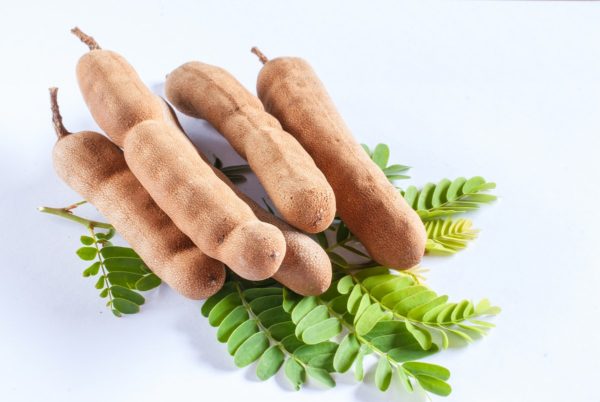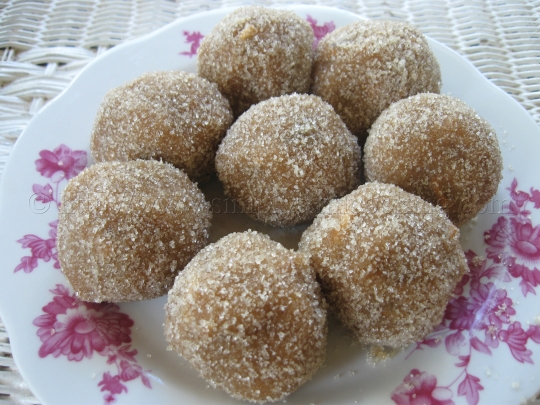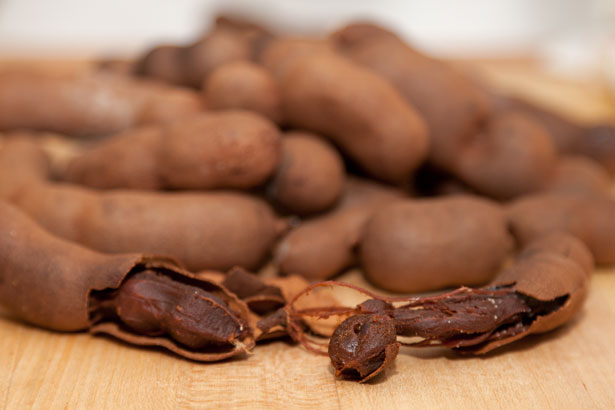Origins of Tamarind
Tamarind trees can be seen scattered across the lands of many Caribbean countries. The plant is indigenous to the tropical region of Madagascar, Africa and started to appear in the 16th century thanks to Spanish and Portuguese colonizers that began cultivating these trees to be used in cooking, folk medicine and wood working.

Image showing Tamarind. Photo Source: https://www.rawpixel.com/search/tamarind?page=1&sort=curated&tags=%24landscap
Description
The tree grows to about 24 metres (80 feet) tall and bears alternate, pinnately compound (feather-formed) leaves with leaflets that are about 2 cm (0.75 inch) long. The yellow flowers are borne in small clusters. The fruit is a plump legume 7.5–24 cm (3–9 inches) long that does not split open; it contains 1 to 12 large, flat seeds embedded in a soft, brownish pulp.
Nutritional Properties
Nutrients per Serving
- Calories: 143
- Protein: 2 grams
- Fat: 0 grams
- Carbohydrate: 38 grams
- Fiber: 3 grams
- Sugar: 34 grams
Uses
Medicine
People take tamarind for constipation, liver and gallbladder problems, and stomach disorders. It is also used to treat colds and fever. Women sometimes use tamarind to treat pregnancy-related nausea. It is also given to children to treat intestinal worms.
An extract known as ‘Mucin‘ of tamarind seeds is used in eye drops for dry eyes. Mucin helps protect and wet the surface of the cornea.
Health Benefits of Tamarind
1. Acts as a Laxative
The juice extracted from Tamarind flowers is used for treating constipation. The juice from Tambarind can also help to stimulate gastric juices and allow for better digestion. The fiber present in Tamarind also helps to improve your bowel movements.
2. Helps in Skincare
Tamarind is a good source of vitamins A and C and also contains an alpha-hydroxy acid (AHA) which is used in many skincare products. It helps with pigmentation and rashes that may occur on the skin.
3. Prevents Cancer
Tamarind is full of many antioxidants and helps to fight cancer cells that build up in the body.
4. Improves your heart health
This fruit is very rich in flavonoids and polyphenols, which are excellent for controlling the levels of HDL-LDL (“good” and “bad” cholesterol) and triglycerides in the blood. Its seed has also shown a relevant modulatory effect on the immune system, which helps control cholesterol levels but also balances your defenses and its impact on your cardiovascular system.
5. Protects your Liver
One of the most affected organs in our system due to modern lifestyle is the liver. It has a crucial role in detoxification and digestion, and it’s mandatory to help him as much as possible. Tamarind could be a great choice to take care of the liver and should be taken as a regular food in case of liver toxicity induced by alcohol or non-alcoholic fatty liver conditions.
You can mix Tambarind juices with refined sugar to give it a sweeter taste without losing any of their effects.
6. Helps with weight loss
Your diet lifestyle is important to keep your weight balanced, not only how much you eat but also WHAT you eat can cause you to gain weight. We have to keep a physically proactive lifestyle, and also eat healthy food, as organic as possible. Tamarind has been shown to regulate lipid metabolism, easing detoxification and correct use of toxic and healthy fat.
Wood Working
Tamarind lumber is used to make furniture, carvings, turned objects such as mortars and pestles, chopping blocks, and other small specialty wood items.
Fun fact: Tamarind heartwood is said to be durable to very durable in decay resistance, and is also resistant to insects.
Cooking
Despite Tamarind originating in Africa it is used in many dishes across the subcontinent of India and is sometimes confused with having its origins from India.
As the fruit matures the pulp can become palatable and consumed raw.
Tamarind paste has many culinary uses including a flavoring for chutneys, curries, and the traditional sharbat syrup drink. Tamarind sweet chutney is popular in India and Pakistan as a dressing for many snacks and often served with samosa. Tamarind pulp is a critical ingredient in flavoring curries and rice in south Indian cuisine.
Tamarind ball is a well known snack that originated in Jamaica.
Here is a simple Tamarind ball recipe
Ingredients
- 1 1/4 cups sugar
- 1 (7-ounce) package tamarind paste*
- 1 tablespoon of Pepper Sauce
- Pinch salt
Preparation
Put 1/4 cup sugar in a shallow plate. Mix tamarind, hot sauce, salt, and remaining sugar in a bowl. Using your hands, mix the ingredients together. Divide the tamarind mixture into bite-size portions, and shape into balls. Add the tamarind balls to the sugar, and roll to coat evenly.
Here is an instructional video on making Tambarind Ball the Guyanese way:
http://https://m.youtube.com/watch?v=ei8YE95kG

Photo of Tamarind Ball. Photo Source: https://commons.m.wikimedia.org/wiki/File:Tamarind_ball.jpg
After biting into this ball of sugary, coated goodness you’ll get a burst of flavour on your tongue with its sweet but also quite spicy taste.
Fun facts about Tamarind:
- The ancient Egyptians cultivated tamarind.
- The etymology of the word “tamarind” shows that it comes from the Arabic “tamar,” or date, and “hindi,” which means “Indian,” hence “tamar hindi,” or tamarind, Indian date.
- Tamarind leaves make up about 50% of the food source for ring-tailed lemurs in Madagascar.
References:
- Fun facts: http://flavorsofthesun.blogspot.com/2014/09/tamarind-facts-fun-and-recipes.html?m=1#:~:text=Tamarind%20leaves%20make%20up%20about,making%20and%20hard%20wood%20flooring
- Origins: https://en.m.wikipedia.org/wiki/Tamarind
- Nutritional Properties: https://www.webmd.com/diet/health-benefits-tamarind
- Health Benefits: https://meditativemind.org/10-benefits-of-tamarind-for-your-health/amp/
Edited on 21st July 2022 at 8:44 pm







